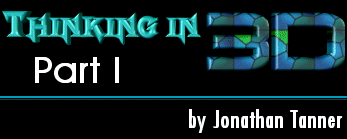11/10 - 11/12 @ Montréal, Canada
12/5 - 12/7 @ Shanghai, China
12/24 - 12/27
2/28 - 3/4 @ San Francisco, CA
More events...
2406 articles in the reference section.
Help us fight cancer!
Join SETI Team GDNet!

|
ConclusionToday, we began our adventure into the world of 3D graphics. We covered the basic coordinate systems used in 3D, and the basic primitive types used in those coordinate systems. If anything seemed fuzzy at all, please go back a reread the article. If you don't completely understand these concepts, you won't have a prayer to understand anything further. If you think that I didn't cover enough, that was deliberate. 3D Graphics is a complicated subject. I don't want to give anyone more then they can handle at once. Next time, we will begin to look at some of the math needed to work with 3D graphics. Once we have that down, we'll learn how to use some of that math to move our points around in our universe. Finally, we are going to begin to think about how we can use points and triangles to represent an object in 3D. Definitions Used In This Article Concave Polygon -- A concave polygon is a polygon with "dents" in it. More specifically, it is a polygon where you can draw a line segment between at least two vertices without the line crossing over the polygon. Convex Polygon – A convex polygon is a polygon with no "dents" in it. More specifically, it is a polygon where you cannot draw a line segment between at least two vertices without the line crossing over the polygon. Collinear – A group of points are collinear if they are all located on the same line Coplanar – A group of points are coplanar if they are all located on the same 2D plane. Left-handed System – The 3D coordinate system defined with the positive Z-axis pointing inward, behind the XY plane. Right-handed System – The 3D coordinate system defined with the positive Z-axis pointing outward, in front of the XY plane. Triangulation – The process of breaking up a complex polygon into its triangle subparts. |
|||||||||||